"California Cowboy" Sculpture
Introduction
Text-to-speech Audio
At the main entrance of the Earl Warren Showgrounds on Calle Real just off the 101 Freeway at the Las Positas exit, we encounter the “California Cowboy.” This sculpture was erected in 1967 in honor of Earl Warren, California’s Governor (1943 to 1953) and Chief Justice of the United States (1953 to 1969). The sculptor is Francis “Duke” Minturn Sedgwick, known also as a civic leader, novelist, art collector, UC Santa Barbara benefactor, and cattle rancher.
Sedgwick’s Cowboy not only signals the equestrian purpose of the showgrounds, but it also presents a mid-twentieth-century characterization of this place and its history as “western,” and “pioneering.” The “California Cowboy” reflects its creator’s image of who was equestrian and when “equestrian” is identified with Santa Barbara. The sculpture therefore represents two moments in history – the mythical California past and the 1960s interpretation of that past. The genre of “Cowboy Commemoration Art” is a controversial topic and has sparked debate among scholars and activists alike for its connotations of racism, nationalism, and nostalgia for a Romantic and idealized perspective of the West. Proponents counter that the Cowboy symbolizes traditional patriotic American values based on historical notions of pioneers taming the wilderness of the early American West. Referred to as "an American fantasy of history" by the art historian, J. Gray Sweeney, this perspective threatens to erase important figures and events from our historical narrative and can lead to wide ranging negative consequences. In particular, these complicated understandings of the Cowboy as a white American cultural symbol stem from the idea that Anglo cowboys and other settlers "discovered" an empty landscape and settled it, erasing the histories of the indigenous peoples and their rich cultures that flourished there long before. Furthermore, mythologizing the cowboy as white preferences an Anglo-Californian history. Who was actually managing cattle in Santa Barbara during the eighteenth and nineteenth century? The answer might surprise you. The art historian Michael Grauer recently spoke at the Sid Richardson Museum about the tendency in art, literature, and film of depicting cowboys as white gunslingers, when historical records demonstrate they were typically Black or brown slaves and vaqueros. Whether we’re talking about Sedgwick’s “California Cowboy” or Clint Eastwood’s character in the 1964 film, A Fistful of Dollars, it is important to recognize that this cowboy image was a 1960s construct that doesn’t reflect the historical understandings of the 2020s.
Regardless of where you might stand on this controversial issue, learning more about different perspectives on our local monuments and histories makes us all feel more invested in our community.
This bronze equestrian statue depicts a cowboy astride his horse holding the reins with both hands near the handle of his saddle. His head is bowed slightly. He wears a cowboy hat, chaps and spurs. The sculpture is mounted atop a tall, rectangular concrete base.
A plaque on the front pedestal reads:
THIS STATUE OF A CALIFORNIA COWBOY
ON A CALIFORNIA COWPONY, SYMBOLIZING
THE VANISHED FRONTIER AND A VANISHING TYPE,
IS DEDICATED IN 1967 TO
EARL WARREN
GOVERNOR OF CALIFORNIA
AND
CHIEF JUSTICE OF THE UNITED STATES
SCULPTOR:
R. M. SEDGWICK
There is some lack of consensus regarding the identity of the man who modeled for Sedgwick’s sculpture. One source suggests that Sedgwick used his own ranch foreman, while another source claims the sitter was “Texas-born Lefty McPeeters who came here in 1936, loved the Fiesta and rodeos, and rode at Earl Warren many times.”[1]
Sedgwick’s other local sculptures include: the cowboy bas relief[2] in the corridor of the Hollister building; St. Francis, made for Christ the King Convent in Montecito, now located at St. Francis Medical Center in Santa Barbara.; Saint Barbara, in the patio of the Santa Barbara Historical Society Museum; and the conquistador at Cabrillo Senior High School in Lompoc.
[1] Phone conversation with Kevin Snow, president of the Earl Warren Showgrounds Foundation, May 21, 2021; Carol Storke, “Horses and Horse Sports in Santa Barbara County 1919-2001,” Noticias: The Quarterly Magazine of the Santa Barbara Historical Society, Vol. XLVII, No. 2 (Summer 2001), 45.
[2] A relief is a type of sculpture where the sculpted elements remain attached to a solid background and the image projects outwards. Unlike a high relief, a bas relief has a very shallow depth (similar to a coin).
Images
California Cowboy by Sedgwick at the Earl warren Showgrounds (1967)
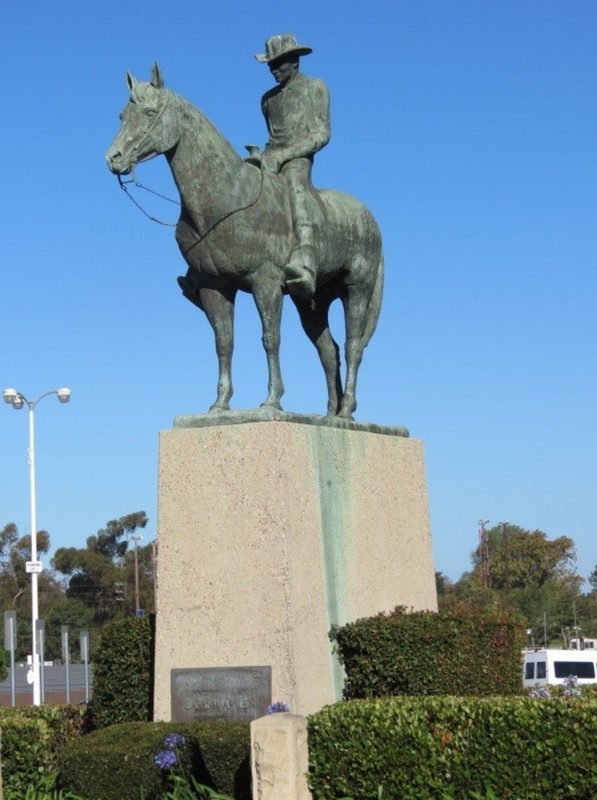
Plaque
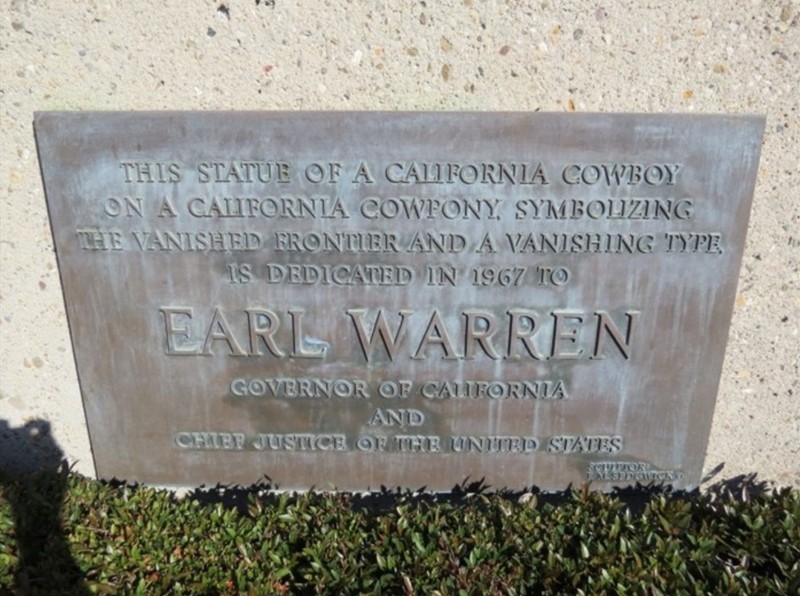
Sedgwick running cattle on his 6,000-acre Rancho la Laguna, which he later donated to the University of California Santa Barbara
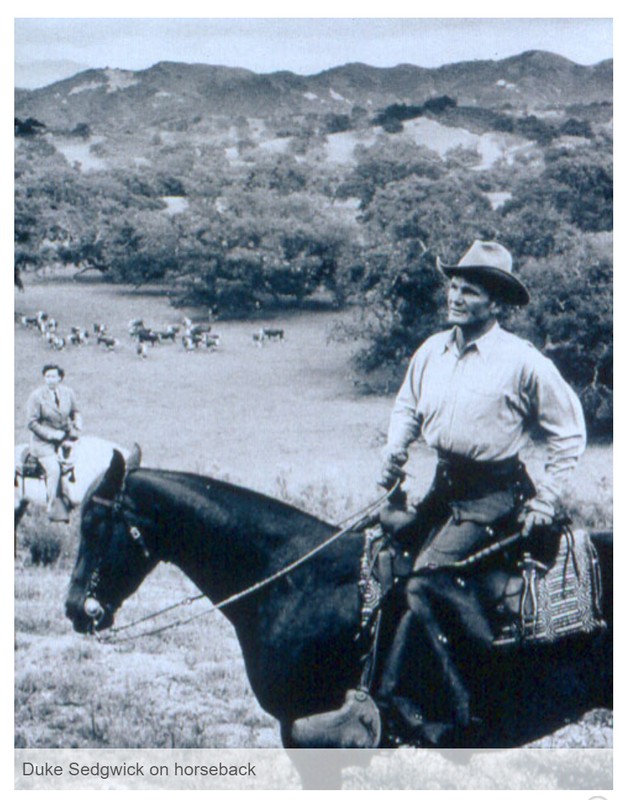
"The Conquistador: Prime Example" by Sedgwick at Cabrillo High School, Lompoc, California (1967)
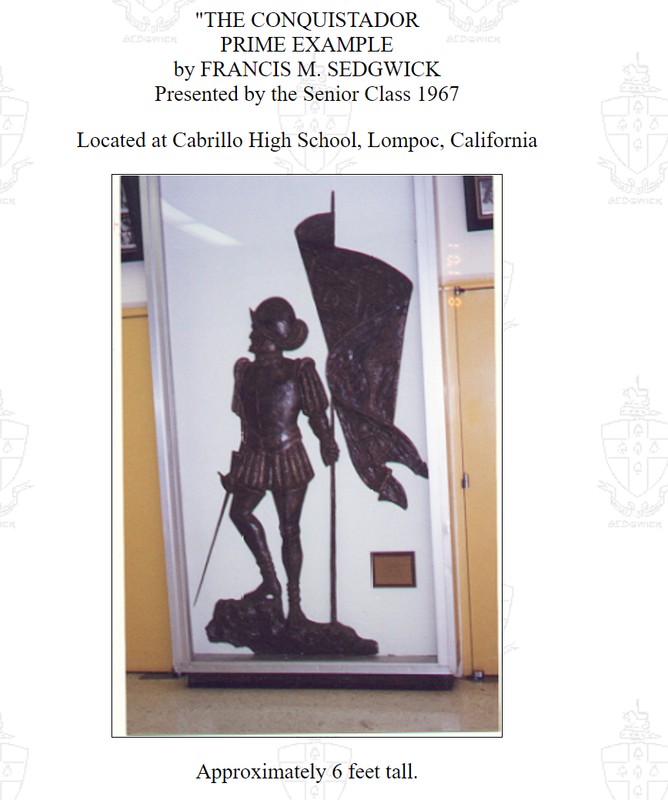
"Independence and the Opening of the West" mural for the Harry S. Truman Presidential Library in Independence, Missouri (1961)
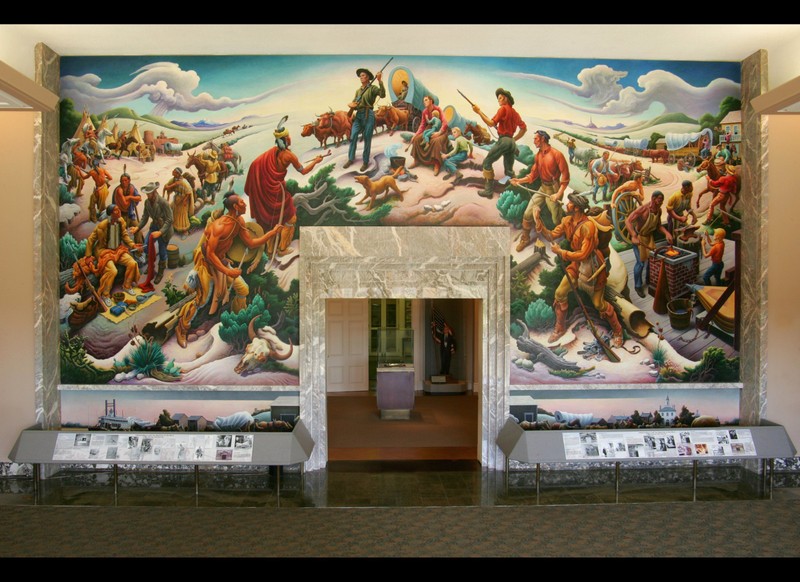
"The Sentinel" by Frederic Remington (1889), Sid Richardson Museum
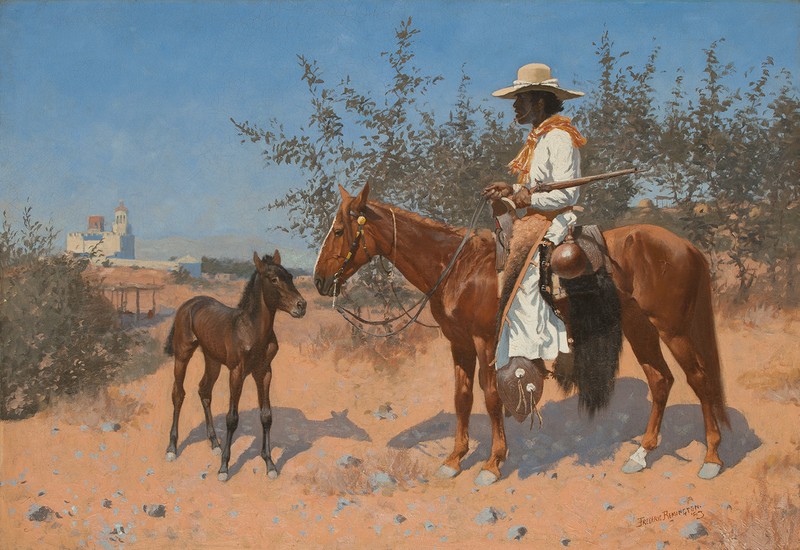
"California Vaquero" by Joe de Yong ( c. 1950), National Cowboy and Western Heritage Museum
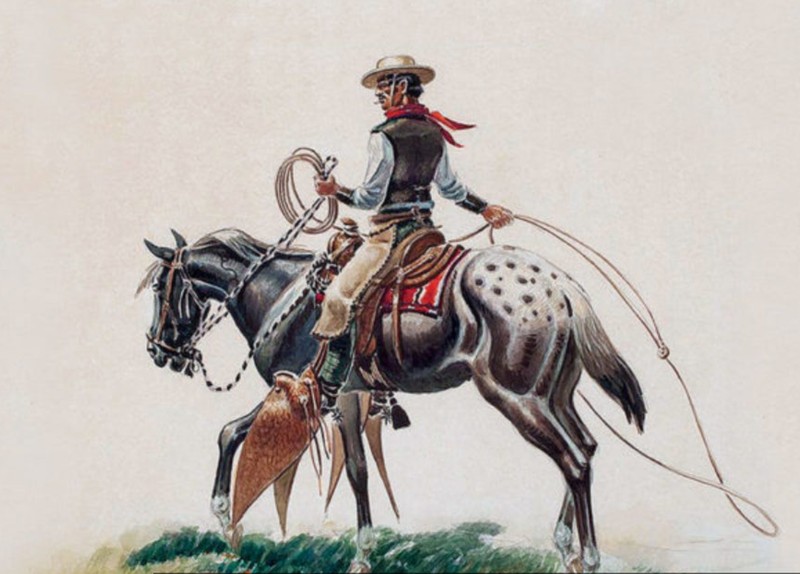
Backstory and Context
Text-to-speech Audio
Why a cowboy?
You might be wondering why Sedgwick chose a cowboy as the subject for this monument dedicated to Chief Justice Earl Warren and why it was installed at the Earl Warren Showgrounds. Sedgwick didn’t leave us any direct statements about his choice here, but as historians, we can make some likely inferences.
Firstly, Sedgwick saw himself as a cowboy-figure. His obituary describes him as a “rancher-artist,” and he spent his days running cattle on his 6,000-acre Rancho la Laguna, which he later donated to the University of California Santa Barbara.[1] We can see the influence of the Cowboy/Old West artistic genre and the “Frontier Myth” perspective of American history in many of Sedgwick’s public sculptures. Richard Slotkin, a renowned scholar of the American West, defines the frontier myth as "America as a wide-open land of unlimited opportunity for the strong, ambitious, self-reliant individual to thrust his way to the top." [2] Think Lone Ranger and other outdated 20th century images of gunslinging heroes dispensing frontier justice, the pioneer family hacking out a life in the wilderness, circling the wagons for a last stand against Native American villains, and “Cowboys vs Indians” epics. Many of Sedgwick’s public sculptures seem to have been influenced by this vision of America. For example, his cowboy bas relief in the corridor of the Hollister building and his 1967 sculpture titled “Conquistador: Prime Example” at Cabrillo High School in the nearby city of Lompoc, whose school mascot is “the conquistadors.”[3]
Secondly, Sedgwick likely considered a cowboy to be a highly appropriate theme for the Earl Warren Showgrounds, which was built in the late 1950s and was first created as the site of the Santa Barbara Fiesta Stock Horse Show & Rodeo. This event dated back to 1924 and featured showing stock horses, cattle work and roping. According to a history of the Showground, the “competencia de vaqueros” was the highlight of these early “fiestas” where cowboys from surrounding ranches demonstrated their roping and riding skills. Rancher J. J. Hollister (whose name we all recognize from Goleta’s Hollister Street) awarded a handmade saddle to the winner. Beginning in the 1960s, there was an annually chosen Honorary Vaquero. The Showgrounds website notes that the Honorary Vaquero’s “intentions were to honor Old Timers who so often go through life unrecognized.”[4] The Showgrounds was initially funded in 1950 by Dwight Murphy, described as “the silent, behind-the-scenes, often high-dollar influence that made possible a myriad of still-existing Santa Barbara Landmarks,” including Stearns Warf, the equestrian Fiesta Parade, East Beach, and numerous parks. He also co-founded the Santa Barbara Trust for Historic Preservation with Pearl Chase and co-founded the Master Planning Committee which set out to rebuild Santa Barbara in the Spanish style after the 1925 earthquake.[5] The showgrounds is now administered by California’s 19th District Agricultural Association and supported by the Earl Warren Showgrounds Foundation.[6]
According to Carol Storke, the decision to name the showgrounds after Earl Warren came from her father, Charles Storke, who served as president of the 19th District in 1956. In her article on Horses and Horse Sports in Santa Barbara for the Historical Society, Carol Storke shares her father’s reminiscences,
“I took Governor Earl Warren to the top of the hill overlooking the site. I told him, ‘This will be the new horse show facility, and we plan to name it after you.’ The Governor only said, ‘That ravine?’ But when the City Council approved the deal, he agreed on the use of his name – the only facility in California he allowed to be honored in this way.” The ravine was filled in, and the “Earl Warren Park,” soon re-named Earl Warren Showgrounds, was dedicated in July 1958.[7]
But ultimately, we don’t know who commissioned the statue or why Sedgwick chose to honor Chief Justice Earl Warren with a cowboy sculpture. There is no indication that Warren was an avid horseman or took any particular interest in horse sports. Some American political figures – such as presidents Theodore Roosevelt, Lyndon B. Johnson, Ronald Reagan, and, most recently, George W. Bush – have cultivated images for themselves as cowboys and have been either accused of or acclaimed as embodying “Cowboy Politics.” [8] However, Warren’s track record of predominantly bipartisan decisions precludes him from association with this brand of politics. Warren is most favorably remembered for his role in combatting racism with his decisions in Brown v. Board of Education, the famous 1954 case that ruled segregation in public schools unconstitutional. However, Warren’s name has recently been involved in contemporary commemoration controversies for his support of Japanese-American internment during the Second World War. G. Edward White, professor of law at the University of Virginia and clerk to Warren in the 1970s, critiques Warren’s involvement in relocation efforts in his article for Virginia Quarterly Review,
Warren was an initial proponent of the Japanese relocation policy and a defender of that policy once it had been implemented. In 1943, when the Allied forces had begun to neutralize Japanese supremacy in the Pacific, fears of an invasion of the West Coast subsided, and pressures to release interned Japanese began to surface. In a conference of state governors that June, Warren vigorously opposed releasing any Japanese. “If the Japs are released,” he said, “no one will be able to tell a saboteur from any other Jap. . . . We don’t want to have a second Pearl Harbor in California. We don’t propose to have the Japs back in California during this war if there is any lawful means of preventing it.”[9]
White notes that, decades later, Warren “Deeply regretted the removal order and [his] own testimony advocating it.” Even so, this connection between Warren and the outrages to Japanese-Americans he helped perpetrate should cause us to question what the act of attaching Warren’s name to the showgrounds and to the “California Cowboy” represents. In his speech at the 1961 dedication ceremony for Thomas Hart Benton’s mural, “Independence and the Opening of the West,” for the Harry S. Truman Presidential Library in Independence, Missouri, Warren suggested that the American Frontier Myth resonated with him.
"As our people come to visit the Truman Library," Warren said, "their eyes will fall upon this great mural, and if they see it with eyes brightened by a knowledge of our own history every figure in it will have meaning for them and will help to build within their hearts a deep and abiding patriotism. The knowledge of our heroic past will open vistas for them into our future."[10]
This mural illustrates the history of Independence Missouri (President Truman’s hometown) and the westward movement across America via the Oregon and Santa Fe trails. And as you can see, the mural depicts many of the themes typically associated with the Frontier Myth and Cowboy Art. The central figures are a pioneer family: an appropriately maternal figure providing food and childcare, the men of the family standing defiantly with rifles pointed towards approaching Native Americans from the Pawnee tribe. The primitive quality of indigenous life is intentionally juxtaposed against expanding white civilization (the endless westward bound wagon train) and American industry. And of course, the Anglo cowboy is present.[11]
Many historians and art-historians have addressed the problematic nature of Cowboy Art as a genre. Beginning in 1992, J. Gray Sweeney, an expert on the art of the American West, was commissioned to write the catalogue introduction for an exhibition of fifty works from the National Cowboy Hall of Fame Museum for the Albuquerque Museum of Art. Sweeny’s introduction, which was critical of the Cowboy Art genre, was initially accepted by the Albuquerque Museum. However, the Cowboy Hall of Fame rejected Sweeny’s work as 'unpatriotic in tone', and threatened to withdraw their exhibition from the Albuquerque Museum. The Museum was pressured to remove Sweeny’s work from their catalogue and allowed the Cowboy Hall of Fame to censor many of Sweeny’s catalogue entries. Sweeny’s subsequent article, “Racism, Nationalism, and Nostalgia in Cowboy Art,” published in the Oxford Art Journal, exposes this censorship and offers a discussion of why Cowboy Art is so problematic. As Sweeny writes, “Although the myth of the cowboy hero represented him as white, in reality he was usually Black or brown. He was often a former slave or a vaquero, or a descendent of slaves or vaqueros.”[12] He argues that we should be aware of what this style of art evokes, explaining that,
“The cultural values exposed here are racism, nationalism and nostalgia, which threaten the conventional historical notions of pioneers establishing a righteous American Empire in the West. It is an art form implicitly endorsing the suppression of Native Americans who are condemned as 'savages', for resisting white expansion into the West, or patronized for their lack of 'culture'. The cowboy hero - a macho figure of the imagination who has been enshrined in the consciousness of the world as an archetypal protagonist of American history - is the mythic persona fostered in this historical vision of the past as a national morality play.”[13]
Michael Grauer, an authority on the art history and culture of the American West and current Chair at the National Cowboy & Western Heritage Museum in Oklahoma City, gave a lecture in April 2021 about the racial diversity of cowboys in the American West. He explains how we can actually trace the roots of the so-called iconic American image of the Western cowboy back to north and west Africa, up through Spain, and then over to the New World. Grauer takes a new approach in his discussion of Cowboy art and culture, exploring how global traditions manifested into a unique Western visual tradition. For example, you might not have known that the style of cattle-roping we associate with the white American cowboy originated in Muslim-ruled Al-Andalus, the part of modern-day Portugal and Spain that was conquered by the Islamic Umayyad Caliphate in the 8th century. Additionally, most of the equestrian technology used by cowboys in the American West, such as the particular style of saddle and spurs, came from areas of West and North Africa. Grauer's research aligns with that of other scholars who have found that at least 1 in 5 cowboys were people of color and that the majority of cowboys who ran cattle in southern Texas along the Gulf Coast were of African descent. He also pointed out that the very first cowboys were indigenous people - a concept that flips the traditional "Cowboy vs. Indian" narrative popularized in film and fiction.[14]
Understanding the origins, development, and implications of the “California Cowboy” statue as defining this Santa Barbara place and implicitly, its history, can help us become better informed citizens of Santa Barbara – a city with its own problematic history of colonialism. The more we know about our city’s history and its public monuments, the more we recognize and appreciate both the original settlement and continuous shaping of this place by the Chumash, and the role that people of color have played in this city’s history.
To discuss the partiality of this artistic representation and the choice to display it in the 1960s, is to open constructive questioning of what defines “our” history? So now that you’ve learned about the “California Cowboy” and its origins, what would YOU would depict here if you could design a commemorative monument to Santa Barbara’s equestrian history?
[1] Obituary for Francis Minturn "Duke" Sedgwick (1904 - 1967). October 25, 1967. http://www.sedgwick.org/na/families/robert1613/B/4/7/4/2/3/B47423-sedgwick-francis-obits.html
[2] Richard Slotkin, Regeneration Through Violence: The Mythology of the American Frontier, 1600-1860 (Middleton: Wesleyan University Press, 1973), 5.
[3] Cabrillo High School Athletics Website. https://www.cabrillosports.org/teams/?u=CABRILLOHS&s=htosports
[4] “History,” Fiesta Stock Horse Show and Rodeo, © 2021 Santa Barbara Fiesta Stock Horse Show & Rodeo
Website, https://www.sbfiestarodeo.org/about-the-rodeo/history/
[5] Rob Kuznia “Do You Know Dwight Murphy?”, Noozhawk, March 23, 2008, https://www.noozhawk.com/article/do_you_know_dwight_murphy
Details from this article were informed by the book, California's Knight on a Golden Horse: Dwight Murphy, Santa Barbara's Renaissance Man, by Edward A. Hartfeld (2007).
[6] A special thanks to Diane Isaacson, Vice President of the Earl Warren Showgrounds Foundation, who shared valuable historical information about the showgrounds and the “California Cowboy.”
[7] Storke, “Horses and Horse Sports,” 45.
[8] “Like a Cowboy: Imagery in Politics, Prose and Reality,” National Cowboy & Western Heritage Museum Webpage. https://nationalcowboymuseum.org/explore/like-cowboy-imagery-politics-prose-reality/
[9] G. Edward White, “The Unacknowledged Lesson: Earl Warren and the Japanese Relocation Controversy,” Virginia Quarterly Review (Autumn) 1979, https://www.vqronline.org/essay/unacknowledged-lesson-earl-warren-and-japanese-relocation-controversy
[10] Raymond H. Geselbracht, “Harry S. Truman, Thomas Hart Benton, and the Making of the Mural,” National Archives Spring 2009, vol. 41, no. 1, Last modified March 11, 2019. https://www.archives.gov/publications/prologue/2009/spring/benton.html
[11] “Independence and the Opening of the West: Thomas Hart Benton,” Harry S. Truman Library & Museum Website, National Archives. https://www.trumanlibrary.gov/education/lesson-plans/independence-and-opening-west-thomas-hart-benton
[12] J. Gray Sweeny, "Racism, Nationalism, and Nostalgia in Cowboy Art," Oxford Art Journal 15, no. 1 (1992): 11.
[13] Sweeny, "Racism, Nationalism, and Nostalgia in Cowboy Art,” 2.
[14] Michael Grauer, “Caballeros y Vaqueros,” Public lecture at the Sid Richardson Museum of Fort Worth Texas. April 16, 2021. https://sidrichardsonmuseum.org/events/virtual-lecture-caballeros-y-vaqueros/cancel/55974952ae4e7a5c5e78e765332e8aec/
[AR1]some places online say Warren IS the cowboy https://www.alamy.com/stock-photo-former-california-governor-earl-warren-on-a-horse-bronze-statue-earl-27570229.html
Sources
https://www.waymarking.com/waymarks/WMEW66_California_Cowboy_Santa_Barbara_CA
https://www.waymarking.com/waymarks/WMEW66_California_Cowboy_Santa_Barbara_CA
https://sedgwick.nrs.ucsb.edu/about/history
http://www.sedgwick.org/na/families/robert1613/B/4/7/4/2/3/B47423-sedgwick-francism-sculptures.html
https://www.trumanlibrary.gov/education/lesson-plans/independence-and-opening-west-thomas-hart-benton
